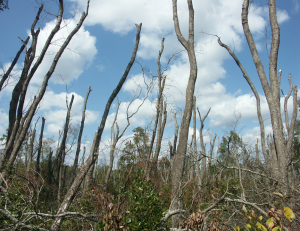Developing indicators of forest biodiversity and ecosystem function across broad regions

Southern Appalachian cove hardwood forest, North Carolina
SUMMARY: Biodiversity conveys numerous benefits to forested ecosystems, including increased productivity and resilience to disturbance. But how should we quantify tree biodiversity in a forest? One way is to simply count the species that live there. A more useful way might be to measure how closely related to each other all the species are. Such measures of evolutionary or phylogenetic diversity could more accurately predict the diversity of ecological functions provided by a forest because species that are phylogenetically distinct – that is, not closely related to other species in the community – should have traits and provide services that are not offered by species that are more closely related to each other.
I work with Forest Service scientists in the use of evolutionary diversity metrics to assess the relationship between biodiversity and forest function (including live aboveground tree biomass accumulation and resistance to non-native plant invasion) across broad U.S. regions, using data from tens of thousands of Forest Inventory and Analysis (FIA) plots. This work required the assembly of a phylogenetic “supertree” describing the evolutionary relationships among nearly 400 North American tree species, based on approximately 100 peer reviewed articles describing the evolutionary relationships among plant species. A 2018 paper published in the journal Biological Conservation identifies the most evolutionarily distinct tree species in the United States, and assesses whether conservation areas across the United States adequately protect evolutionary distinctiveness and rarity of forest tree species.
PROGRESS: This project uses Forest Inventory and Analysis (FIA) data at a variety of spatial scales to characterize forest tree phylogenetic diversity, a measure of community composition that incorporates evolutionary relationships among species. Seven journal articles have been published, as well as a chapter in the Forest Health Monitoring national report and a conference proceedings paper.
This research has been described in a number of presentations and papers.
LINKS:
CONTACT: Kevin Potter, kevin.usda.gov or (919) 549-4071



